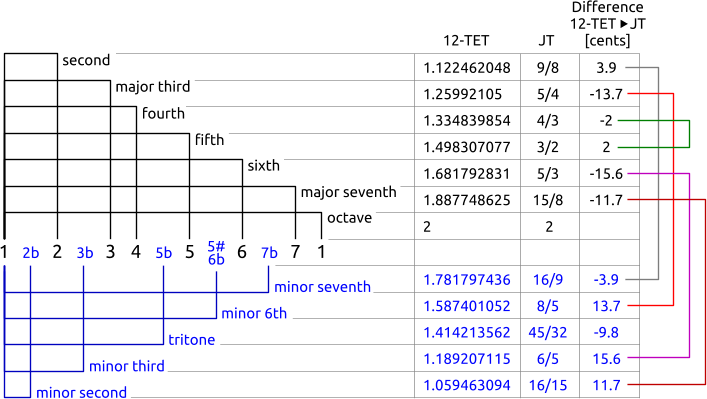This page focuses on the differences between two tuning systems:
JT (= Just Tuning or Just Intonation), and
12-TET (= 12-Tone Equal Temperament).
Let us start with the latter, 12-TET, which is the newer one. Then we will look at JT to understand why it is (more) relevant to harmony singing.
12-TET
12-TET was invented or, if you will, discovered in the late 16th century independently in Europe and China. An octave is a tone interval between two notes perceived to be the same note except that 'one is higher'. In terms of physics, two notes an octave apart have a frequency ratio of exactly 2, independent of their actual pitch. Tuning systems are all about frequency ratios, not about pitch.In the 12-Tone Equal Temperament system the octave is divided into 12 equal steps called semitone, half tone, or half step, with 'equal' meaning the same frequency ratio between ANY notes a half tone apart. Math tells us that this ratio is the 12th root of 2, which is 1.0594631..., a number with an infinite number of digits after the decimal point.
The guitar and other fretted instruments in Western culture are 12-TET condensed into matter. The positioning of frets follows that half tone ratio in that the distance between the bridge and any fret is by 1.0594631... longer than the distance between the bridge and the adjacent fret nearer to the bridge — well, theoretically. Theoretically, because... frequency is inversely proportional to string length provided that the string tension is constant — and that's the point. Fretting a string causes different tension depending on which fret it is pressed. So, a good luthier will make slight corrections to the rule, BUT that has nothing to do with 12-TET!
Want to know the frequency f2 three half steps or guitar frets up from frequency f1 ? Just do this multiplication:
f2 = f1 * 1.0594631 * 1.0594631 * 1.0594631
...and you get a fairly accurate number of 1.1892071 * f1
So, to wrap it up, the forte of the 12-TET system is pitch-independence! It is the equalizer of all keys. But what about 12-TET's cons?
Have you noticed my conscious effort not to mention wind instruments and the whole violin family? What about the human voice? What would happen if our vocal cords were tuned according to 12-TET? Well, let me assure you that harmony singing would sound pretty awful.
Just Tuning / Just Intonation
So, what was music like before 12-TET? In a nutshell, it was based on 'pure intervals' whose rules go back 2.5 millennia to Pythagoras of Samos. Pure intervals used in Just Tuning or Just Intonation are perceived as pure because their frequency ratios are simple common fractions unlike 12-TET's decimal numbers above.In order to numerically compare 12-TET with JT, we need to divide the half tone into very small steps called cents, and as the name suggests, 100 cents make up a half tone, and 1,200 cents make up an octave. Again, a cent is the same frequency ratio regardless of pitch, and math tells us that this ratio is the 1,200th root of 2 = 1.0005778...
Comparison 12-TET vs. Just Tuning / Just Intonation
Here's an overview of the intervals in an octave and their names, and the difference between 12-TET and JT in cents. The 12-TET and JT columns show their frequency ratios relative to the key note or tonic, 1:

For some notes, several simple frequency ratios are possible, such as the 10/9 for the second instead of 9/8, and 9/5 instead of 16/9 for the minor seventh. For the purpose of this website, 9/8 and 16/9 have proven to produce better intervals.
Please note the symmetry in the cent numbers.
Let's put these two systems to the major third test:
Let the key be A, so, 1 = A3. Let us calculate its major third note, C#4, which is a half tone above C4.
A3's frequency is 220 Hz, one octave below concert pitch (A 440 Hz, Hz = Hertz = oscillations per second). The major third in 12-TET has a frequency ratio of 1.25992105, so, to get the frequency of C#4 we multiply 220 with 1.25992105:
12-TET: fC#4 = 220 * 1.25992105 = 277.182631 Hz
However, in JT, we have to multiply 220 with 5/4 according to the table above:
JT: fC#4 = 220 * 5/4 = 220 * 1.25 = 275 Hz
In this audio these two different C#s are alternating:
Check out the difference in the complete A major chord (A3 C#4 E4):
| A major chord in 12-Tone Equal Temperament | |
| A major chord in Just Tuning / Just Intonation |
The major third lowered by 13.7 cents in JT makes for a pure listening experience while the 12-TET chord is really..... ugh!
They say that a deviation of 4 cents (= 25th of a half tone) is audible. So, the table and these audios tell us that singing JT notes really makes a difference, especially regarding minor 3rds, major 3rds, 6ths, and 7th.
How do we learn to sing JT notes when singing harmony? It's very simple: Just find the right pitch, which is when all impurities are gone... When you sing harmony, never exactly copy 3rds, 6ths, and 7th scale notes from fretted instruments, not even from a piano!
The advice above notwithstanding, 12-TET and JT have successfully coexisted for at least 300 years, with non-fretted instruments being able to adjust to what sounds best in the context.
For more on the topic, you may visit Wikipedia's Equal temperament and Just intonation.
However, single notes played by clicking anywhere on the editor grid are, for lack of chordal context, not corrected.
